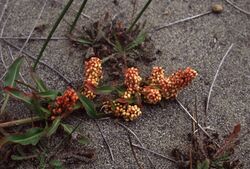Biology:Rumex salicifolius
| Rumex salicifolius | |
|---|---|

| |
| In fruit | |
| Scientific classification | |
| Kingdom: | Plantae |
| Clade: | Tracheophytes |
| Clade: | Angiosperms |
| Clade: | Eudicots |
| Order: | Caryophyllales |
| Family: | Polygonaceae |
| Genus: | Rumex |
| Species: | R. salicifolius
|
| Binomial name | |
| Rumex salicifolius Weinm.
| |
Rumex salicifolius is a species of flowering perennial plant in the knotweed family known by the common names willow dock[1] and willow-leaved dock.[2] It is native to much of western North America, and more specifically, in southern and central parts of California, and some parts of Arizona and Nevada.[3] It can also be found in parts of Europe as an introduced species and a roadside weed. It is an extremely variable plant which is generally divided into many varieties, some of which may actually be specimens of other species.[4]
Description
In general, it is a perennial herb producing a slender stem which is prostrate and spreading or erect, growing up to about 90 centimeters in maximum length. The leaves are up to about 13 centimeters long and can be most any shape. The inflorescence of this plant is an interrupted series of clusters of flowers. There are up to 20 flowers in each cluster, and each flower hangs from a pedicel. The flower usually has six tepals, the inner three of which are largest and usually have central tubercles. It is an important food and host plant for Lycaena rubidus larvae.[5] This plant usually is green colored with hints of pink and red.[6] It is also a Perennial plant, meaning that this plant usually lives for 2 or more years.
Distribution
Rumex salicifolius is found in different parts of California, along with being found in Arizona, Nevada, and Northern Mexico. More recently it has been found as an introduced species in parts of Europe.[7]
Habitat
Rumex salicifolius is typically found in wet places, but not flooded environments. These are areas adjacent to seasonally flooded wetlands, though. These plants can also be found on rocky slopes, and in margins. It's usually found less than 3,500 altitude.[8] The bloom period for this plant is June through September.[9] The plant usually thrives in full sunlight, and only sometimes in partial shade.[10]
Taxonomy
It is a dicot, meaning that the plant has 2 embryonic leaves and/or cotyledons. It is of the kingdom Plantae, the order Caryophyllales, and the buckwheat family, Polygonaceae. The genus is Rumex L.- Dock[11] There are also fifteen different subspecies. These are- Rumex salicifolius var. angustifolius, Rumex salicifolius var. angustivalvis, Rumex salicifolius var. crassus, Rumex salicifolius var. denticulatus, Rumex salicifolius fo. ecallosus, Rumex salicifolius var. lacustris, Rumex salicifolius subsp. mexicanus, Rumex salicifolius var. mexicanus, Rumex salicifolius var. montigenitus, Rumex salicifolius subsp. salicifolius, Rumex salicifolius fo. transitorius, Rumex salicifolius var. transitorius, Rumex salicifolius subsp. triangulivalvis, Rumex salicifolius var. triangulivalvis, and Rumex salicifolius var. utahensis.[12]
Uses
The Zuni people use the mexicanus variety medicinally. A strong infusion of the root is made and given to women by their husbands to help them to become pregnant.[13] The ground root, or an infusion of it, is taken also for sore throat, especially by sword swallowers.[14] This species is also used in the treatment and management of chronic pain of the aboriginal people of the Canadian Boreal Forest. It is used to treat chronic migraine/headache, chronic back pain, and chronic rheumatism/arthritis. In studies it has proven to be successful in aiding people with anti-inflammation and significant pain relief.[15]
References
- ↑ "Rumex salicifolius". Natural Resources Conservation Service PLANTS Database. USDA. https://plants.usda.gov/core/profile?symbol=RUSA. Retrieved 26 October 2015.
- ↑ (xls) BSBI List 2007, Botanical Society of Britain and Ireland, https://bsbi.org/download/3542/, retrieved 2014-10-17
- ↑ "Rumex salicifolius - FNA". http://beta.floranorthamerica.org/Rumex_salicifolius.
- ↑ Flora of North America
- ↑ Warren, Andrew; Harrera, Alfonso. "Butterflies of Oregon Their Taxonomy, Distribution, and Biology". Lepidoptera of North America. https://dspace.library.colostate.edu/bitstream/handle/10217/81121/BSPMGILL_LepidopteraofNorthAmerica6.pdf?sequence=1.
- ↑ "Willow Dock, Rumex Salicifolius". https://calscape.org/Rumex-salicifolius-().
- ↑ "Rumex salicifolius - FNA". http://beta.floranorthamerica.org/Rumex_salicifolius.
- ↑ Severns, Paul M. (2011). "Habitat restoration facilitates an ecological trap for a locally rare, wetland‐restricted butterfly". Insect Conservation and Diversity 4 (3): 184–191. doi:10.1111/j.1752-4598.2010.00120.x.
- ↑ "Plant Characteristics and Associations". https://www.calflora.org/entry/plantchar.html?crn=7225.
- ↑ "Willow dock, Rumex salicifolius". https://calscape.org/Rumex-salicifolius-().
- ↑ "Rumex salicifolius Weinm.". https://plants.usda.gov/core/profile?symbol=RUSA.
- ↑ "Tropicos | Name - Rumex salicifolius var. triangulivalvis (Danser) J.C. Hickman". http://tropicos.org/Name/26001448.
- ↑ Stevenson, Matilda Coxe 1915 Ethnobotany of the Zuni Indians. SI-BAE Annual Report #30 (p. 85)
- ↑ Stevenson, p.59
- ↑ Uprety, Yadav; Lacasse, Anaïs; Asselin, Hugo (2016). "Traditional Uses of Medicinal Plants from the Canadian Boreal Forest for the Management of Chronic Pain Syndromes" (in en). Pain Practice 16 (4): 459–466. doi:10.1111/papr.12284. ISSN 1533-2500. PMID 25776550.
External links
- "Rumex salicifolius". http://www.pfaf.org/user/Plant.aspx?LatinName=Rumex+salicifolius.
- Calflora: Information on California plants for education, research and conservation, with data contributed by public and private institutions and individuals, including the Consortium of California Herbaria, Berkeley, California: The Calflora Database, https://www.calflora.org/cgi-bin/species_query.cgi?where-taxon=Taxon name (parameter 1) is required.
- Jepson Manual eFlora (TJM2) treatment of Rumex salicifolius
- USDA Plants Profile for Rumex salicifolius (willow dock)
- Washington Burke Museum
Wikidata ☰ Q7155438 entry
 |

